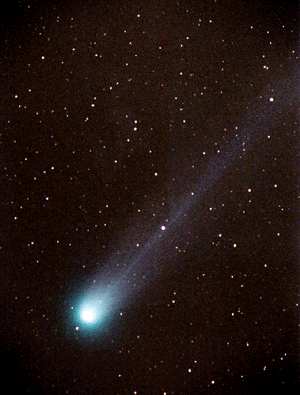
|
Explanation: The tail of comet Hyakutake, visible in this recent color image, is composed of dust and gas driven off the icy comet nucleus by the Sun's heat and blown away by the solar wind. Bathed in solar ultraviolet light, the gas molecules break down and are excited, producing a characteristic glow. This glow is responsible for visible light from the tail and astronomers using spectroscopes can identify the compounds involved. The close passage of Hyakutake presents an excellent chance to use this technique to explore the composition of its tail. Typical comet gas tail constituents are simple combinations of hydrogen, carbon, nitrogen, and oxygen - for example, H20 (water), CO (carbon monoxide), and CN (cyanogen) are common. In fact, the poisonous CO and CN compounds were seen in the spectrum of Halley's comet during its 1910 apparition. This caused some public concern at the time as the Earth was expected to pass through Halley's tail! However, stretching for millions of miles, comet tails are extremely thin and tenuous and don't pose a danger to the Earth's atmosphere.
Latest Comet Hyakutake images:
JPL,
Crni Vrh Observatory,
Slovenia,
Fayetteville
Observer-Times,
NASA's Night of
the Comet
|
January February March April May June July August September October November December |
| ||||||||||||||||||||||||||||||||||||||||||||||||
NASA Web Site Statements, Warnings, and Disclaimers
NASA Official: Jay Norris. Specific rights apply.
A service of: LHEA at NASA / GSFC
& Michigan Tech. U.
Based on Astronomy Picture
Of the Day
Publications with keywords: comet
Publications with words: comet
See also:
- APOD: 2025 September 30 Á Comet Lemmon Brightens
- APOD: 2025 September 29 Á Two Camera Comets in One Sky
- APOD: 2025 September 26 Á A SWAN an ATLAS and Mars
- APOD: 2025 September 18 Á Comet C/2025 R2 SWAN
- APOD: 2025 September 16 Á New Comet SWAN25B over Mexico
- APOD: 2025 July 7 Á Interstellar Comet 3I ATLAS
- Comet C/2025 F2 SWAN
